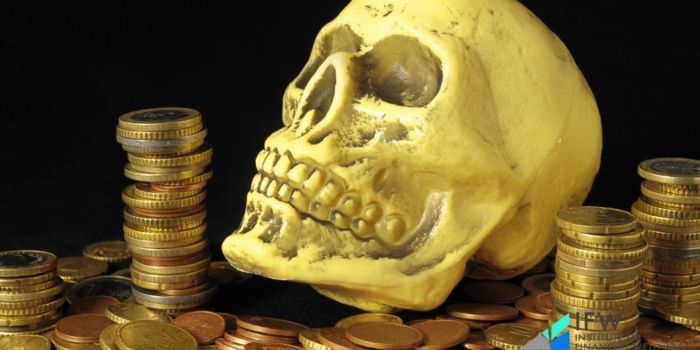Investors can join us in discovering the Halloween Strategy, which looks at market timing and calendar anomalies over a period of time from November to April. We’ll reveal if there are any real gains or losses when taking this ghoulish approach with stocks during these months.
These kinds of investment opportunities should be a part of your retirement plan. The IFW offers custom retirement plans that are complimentary. Sign up here: The IFW Retrement Roadmap.
By uncovering what lies beneath regarding stock market performance for investors throughout the mysterious Halloween season, we will help shed light on just how much magic they should expect here compared to trick-or-treats elsewhere. Thereby providing insight into possible limitations that may be associated with using such an investing tactic.
Key Takeaways
- The Halloween Effect is a market timing strategy that exploits seasonal trading patterns to potentially generate higher returns from November through April.
- Investing in companies related to retail, candy manufacturing, and costume supplies can capitalize on the increased demand during the Halloween season.
- Investors should consider diversifying their portfolios and be aware of potential risks associated with this strategy before incorporating it into their portfolios.
The Halloween Effect: A Market Timing Strategy
The Halloween Effect, a market timing strategy, is based upon seasonal trading patterns which suggest that the equity markets will not perform as strongly during May to October compared to November through April.
Accordingly, investors who choose this investing approach start buying stocks in November and hold them until the end of April before transferring their funds into alternative asset classes. Historically demonstrating greater capital gains over those seen in other months. As such, brave traders may benefit from using this Hallowen-inspired investment scheme for potentially lucrative results.
Seasonal Trading Patterns

The Halloween Effect, which is similar to an otherworldly atmosphere and can also be referred to as the “Halloween indicator”, forms part of a series of seasonal trading patterns having an impact on the stock market. This phenomenon, along with others such as the January Effect and Santa Claus Rally, are linked together in terms of their influence on trade performance.
This period from November through April has been seasonally strong due to its relationship with these aforementioned calendar changes. It has even partially contributed towards generating improved results during January – known for this established pattern when evaluating stocks by the end-of-year benchmarking system.
Lastly, there’s what’s called ‘the Santa Clause Rally’ that usually occurs in the week leading up to Dec. 25 until the first 2 days following up until New Year – typically associated with positive sentiment surrounding holiday cheer.
Bull Market vs. Bear Market
When investors are bullish, and the stock market is experiencing a boom, the Halloween Effect intensifies, with stocks usually performing better throughout winter due to increased consumer spending. This, in turn, drives up share prices.
Conversely, during bearish periods of decline on the markets when it’s “low season”, this phenomenon may not be as prominent. Yet investment strategy-wise, there remains evidence that from November until April, consistent improvements can still prevail – so using those months could prove advantageous for people attempting to make their way through Wall Street’s ever-changing landscape.
The Origins of the Halloween Strategy

Where does all of this come from? When did it all start? The advice commonly heard, “sell in May and go away,” is believed to have started with the privileged class leaving London for their rural homes during summertime without focusing on financial matters. This concept underpins the Halloween Strategy – an indication of when investors should get back into trading after selling at the beginning of season-change being signaled by St Leger Day taking place each September.
This horse racing event marks not just a shift between seasons but also signals that this would be an ideal time to rejoin markets as traders had been encouraged from earlier points in springtime to “sell” so they could reposition themselves again now.
Sell in May and Go Away
The adage, “sell in May and go away” encourages investors to unload their stocks during the month of May so they can return to the market again by November. This strategy takes after what is called the Halloween investing approach, which has its roots in typically poorer stock performance from late spring until early fall.
Whilst it might not be a fail-proof way for traders to outperform other competitors on the market, this notion could offer an interesting starting place when considering seasonal inventory returns and devising a corresponding seasonal trading scheme.
St. Leger Day
The market frequently rallies a few weeks prior to St. Leger Day, the horse racing event that takes place in September and marks an ideal moment for investors to make their return after selling earlier during May – as part of what is known as the Halloween Effect.
Analyzing the Halloween Effect: Does It Work?

The Halloween strategy appears to have been successful in offering investors capital gains over the last half-century. Historical stock returns have affirmed this, as November until April has been found to offer more benefits than other strategies such as buy and hold ones. Especially when considered for five or ten-year horizons. This makes it an attractive option for those looking to take advantage of seasonal market trends, as evidenced by its consistent success rate over time.
November to April Performance
For investors seeking to maximize their returns, the Halloween investing strategy is a lucrative prospect due to its strong performance in the November-April period over multiple decades. Several seasonal patterns, such as the January Effect and the Santa Claus Rally, are responsible for this higher capital gain during that seasonally stronger stretch. This provides an opportunity for traders wishing to benefit from these trends by taking advantage of what happens between November and April each year.
Comparing the Halloween Effect to Buy and Hold
Investors who are interested in seeking out greater rewards have found that the Halloween investing strategy can be a fruitful alternative to simply buying and holding. By centering their portfolio between November and April, those embracing this approach may gain access to higher capital gains than by adhering strictly to buy-and-hold principles.
The Halloween Effect provides an opportunity for proactive investors looking for something different from traditional trading strategies. It has been demonstrated over five or ten-year time horizons as outperforming the more run-of-mill methods applied usually by stockholders.
As such, it stands tall against its main competitor with bright prospects even if entering into unknown territory away from what is expected during standard investment periods like March and October months.
Calendar Anomalies and the Halloween Effect

The stock market is home to many more factors than just the well-known Halloween Effect. The Santa Claus Rally and the January Effect are two key calendar anomalies that can strongly affect how investing in stocks works out during certain periods of time.
Knowing about these seasonal trends will be beneficial for investors aiming to use a successful Halloween strategy when it comes to trading on the market. As such, by taking advantage of this knowledge, they can possibly maximize their profit margins while managing risks along with it as best as possible at that same time.
January Effect
The January Effect is a trend in stock market prices that usually sees an increase during the start of the year. This boost has been attributed to investors disposing of securities at a loss over December, offsetting capital gains made throughout the previous 12 months.
By being aware of this seasonal phenomenon, savvy shareholders may benefit from its presence.
Santa Claus Rally
Investors may be able to capitalize on the upward movement in stock prices known as the Santa Claus Rally when observing this joyous market trend. This increase usually takes place at the end of December and beginning of January, likely because investors are feeling cheerful during holidays or possibly due to portfolio decisions made by institutional investors near year-end. Watching out for potential gains from such seasonal trends could prove profitable!
Halloween Stocks
It’s almost time for trick or treat! As Halloween draws near, and certain stocks that are linked to this season may potentially benefit from the spike in consumer spending. These could include retailers selling decorations and costumes, as well as manufacturers of sweet treats such as candy. By investing in these ‘Halloween Stocks’, investors have a chance to gain profits during this spooky time of year!
For those who want to take advantage of seasonal gains through investments in these stocks, it’s important for them to identify which companies fall under the umbrella term “Halloween” so they can make an informed decision about their portfolio.
Risks and Limitations of the Halloween Strategy

Investors must take into account the possible dangers and limitations when using a Halloween Strategy in their investing. The Efficient Markets Hypothesis, as well as market instability, can significantly influence how successful this approach is for them. To make informed decisions about introducing the strategy to their portfolios, investors should be aware of the risks involved with it – no investment comes without risk included. Even implementing a ‘Halloween Effect’ carries its own potential pitfalls.
As attractive an option that utilizing such technique may seem at times to investors, caution should always prevail before committing capital towards any means of stock picking methodologies or strategies derived from external data points such as this one associated with October 31st trading activity patterns.
Efficient Markets Hypothesis
Investors considering the Halloween investing strategy should be cautious, as it may not provide a guaranteed path to success. This is because, according to the Efficient Markets Hypothesis (EMH), stock prices incorporate all available information, meaning that market fluctuations have likely already adjusted for seasonal trends that are being capitalized on by this approach.
As such, investors must bear in mind the potential implications of EMH when deciding whether or not to implement the Halloween technique.
Market Volatility
When assessing stocks and their performance, market volatility must be taken into account. This is basically a measure of how quickly prices are changing over time – wild changes can have an adverse effect on any Halloween strategy being employed by investors. Unforeseen occurrences such as economic meltdowns or geopolitical strains could lead to rapid price fluctuations, which will undermine the viability of this specific investment approach.
In order to reduce these sorts of risks, it’s essential for those utilizing the Halloween Strategy to diversify their portfolios along with appropriate timing and execution tactics for maximum advantage in stock trading opportunities associated with this methodical system.
Practical Tips for Implementing the Halloween Market Strategy

Investors who wish to capitalize on the potential gains offered by a Halloween Strategy must gain an in-depth understanding of market trends and consider various elements such as timing, diversification, and execution.
To effectively navigate these factors while minimizing risks associated with this investing method, investors should access resources available at The Institute of Financial Wellness, which provide helpful knowledge surrounding seasonal trading patterns like the ‘Halloween Effect’ and investment techniques more broadly. Doing so ensures that investments are made based on comprehensive financial information rather than guesswork or emotion alone.
Diversification
Investors must diversify their portfolios in order to minimize risk and safeguard it from market volatility. Allocating investments across different asset classes and industries provides investors with the ability to reduce individual investment influence over an entire collection of assets.
This form of diversification allows individuals to endure any possible downturns that may occur while still striving for maximum profit opportunities during various kinds of markets.
Timing and Execution
Investors who make use of the Halloween Strategy have an opportunity to capture greater profits and maximize their returns. Timing and execution are essential elements, as appropriate entry into the market, along with timely exits, can substantially influence outcomes. To achieve such success, investors must closely monitor all trends within this space in order to adjust strategies accordingly. By doing so, they will be well-positioned to achieve stronger capital gains from their Halloween strategy investments.

The Institute of Financial Wellness: The Financial Education You Need
At the Institute of Financial Wellness, investors have access to a complete multimedia network providing financial education and resources. Through various offerings such as webinars, online courses, and podcasts, individuals can gain the vital knowledge they need in order to make more prudent decisions regarding finance as well as provide them with strategies for investments.
The goal is to equip those taking advantage of these services with the tools needed so that their journey on this often-challenging terrain may be navigated successfully.
Sign up for our free Retirement Roadmap Webinar to get your financial success started today!
Full Summary
Investors may capitalize on certain market trends in order to enhance their returns by recognizing seasonal trading patterns such as the January Effect and Santa Claus Rally. The Halloween Strategy, a mysterious market timing strategy that suggests stocks perform better from November through April, can be implemented with confidence if investors account for potential risks like those of the Efficient Markets Hypothesis or volatility of markets. This way, they could benefit from this season investing approach and potentially reap its rewards while avoiding any drawbacks that might appear attractive at first glance.
Frequently Asked Questions
What is the Halloween effect on the stock market?
From October 31st (Halloween) to May 1st, it is believed that stock prices are more likely to increase than during the summer months. This pattern has been given the name ‘Halloween effect’, as it suggests a market timing indicator for rising stocks in wintertime.
What is the Halloween effect in Crypto?
Investors could potentially experience higher returns in the market by buying assets during November and then selling them off in April, which is referred to as ‘The Halloween Effect’ within Crypto.
Is Halloween a market holiday?
Halloween is not a recognized market holiday, but the stock market stays open on this day of spookiness. Markets still function as usual despite this festive time.
What stocks go up on Halloween?
Stocks that may show positive movement on Halloween are Farfetch (FTCH), Gap (GPS), Invesco S&P 500 Low Volatility ETF (SPLV) and Mondelez International, Inc. (MDLZ), Stitch Fix, Target Corporation (TGT), TJX Companies, Hershey Co., Tootsie Roll Industries and Walmart Inc. (WMT)




